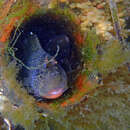Life Cycle
provided by Fishbase
Oviparous, distinct pairing (Ref. 205). Female deposits the eggs in protected areas. The male guards the eggs until hatching (Ref. 37955).
- Recorder
- Cristina V. Garilao
Trophic Strategy
provided by Fishbase
Found in intertidal shallows (Ref. 11482) but restricted to deeper waters (17-26 m) near Cabo San Lucas. Inhabits bays and nearly estuarine waters. Sympatric with H. jenkinsi and H. gilberti but dominant only in newly developed and transient habitat. Moves to Zostrea beds when their transient habitats are disturbed (Ref. 56052). Territorial (Ref. 37955) particularly the males guarding eggs defending even against the females which spawned it. They exhibit a less developed gular display than H. jenkinsi which is more territorially aggressive. The two species occupy much similar areas and actively competes for space, H. gentilis more often loses to H. jenkinsi. Exhibits odd feeding behavior of hanging vertically in midwater during its feeding period (Ref. 56052). Feeds on small benthic invertebrates and algae (Ref. 37955). Predators of Hypsoblennius include Pralabrax clathartus, Pralabrax maculatofasciatus, Heterostichus rostratus, and Scorpaenichthys marmoratus. Other fishes living in the same area include: Paraclinus integripinnis, Gibbonsia elegans (Ref. 56052).
- Recorder
- Grace Tolentino Pablico
Biology
provided by Fishbase
Adults are found in intertidal shallows (Ref. 11482). Territorial (Ref. 37955). They feed on small benthic invertebrates and algae (Ref. 37955). Demersal spawners in nearshore habitats (Ref. 56049). Oviparous (Ref. 205). Eggs are demersal and adhesive (Ref. 205), and are attached to the walls of the parent's shelter. Eggs are brooded by the male parent (Ref. 56053).
Hypsoblennius gentilis: Brief Summary
provided by wikipedia EN
Hypsoblennius gentilis, commonly known as the bay blenny, is a species of combtooth blenny found in the eastern-central Pacific Ocean. This species grows to a length of 15 centimetres (5.9 in) TL.
- license
- cc-by-sa-3.0
- copyright
- Wikipedia authors and editors

